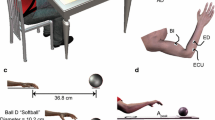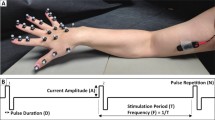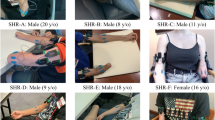Abstract
Congenital insensitivity to pain (CIP), which is an extremely rare sensory neuropathy, is defined as the absence of normal responses to noxious stimuli. Although motor function is not directly impaired in CIP patients, it is likely that the sensory deficit affects the motor control system. In order to characterize motor capacity in CIP patients, we here measured grip force and acceleration of a held object in 12 patients with CIP and 12 age-matched able-bodied subjects. The results demonstrated that the grip force during the object grasp-lift-holding task was significantly greater, less reproducibility and greater fluctuation in the acceleration of the object in CIP patients than in normal subjects. Moreover, some patients showed absence of temporal coupling between the grip and load force, suggesting that anticipatory modulation of the grip force was at least partly impaired. As far as the authors know, this is the first study to characterize motor control ability in patients with CIP. The observed abnormal motor capacity can be at least partly attributed to a lack of sensory inputs mediated by Aδ and unmyelinated C-, specifically C-tactile, fibers. The present results may provide information useful for the prevention of secondary injury and education for patients during the developmental stage.






Similar content being viewed by others
References
Augurelle AS, Smith AM, Lejeune T, Thonnard JL (2003) Importance of cutaneous feedback in maintaining a secure grip during manipulation of hand-held objects. J Neurophysiol 89:665–671
Brochier T, Boudreau MJ, Paré M, Smith AM (1999) The effects of muscimol inactivation of small regions of motor and somatosensory cortex on independent finger movements and force control in the precision grip. Exp Brain Res 128:31–40
Craig AD (2009) How do you feel–now? The anterior insula and human awareness. Nat Rev Neurosci 10:59–70
Dyck PJ, Mellinger JF, Reagan TJ, Horowitz SJ, McDonald JW, Litchy WJ, Daube JR, Fealey RD, Go VL, Kao PC, Brimijoin WS, Lambert EH (1983) Not ‘indifference to pain’ but varieties of hereditary sensory and autonomic neuropathy. Brain 106:373–390
Ghez C, Gordon J, Ghilardi MF (1995) Impairments of reaching movements in patients without proprioception. II. Effects of visual information on accuracy. J Neurophysiol 73:361–372
Goodwin AW, Wheat HE (2004) Sensory signals in neural populations underlying tactile perception and manipulation. Annu Rev Neurosci 27:53–77
Hager-Ross C, Johansson RS (1996) Nondigital afferent input in reactive control of fingertip forces during precision grip. Exp Brain Res 110:131–141
Hermsdorfer J, Hagl E, Nowak DA (2004) Deficit of anticipatory grip force control after damage to peripheral and central sensorimotor systems. Human Mov Sci 23:643–664
Johansson RS, Westling G (1984) Roles of glabrous skin receptors and sensorimotor memory control of precision grip when lifting rougher or more slippery objects. Exp Brain Res 56:550–564
Johansson RS, Hger C, Bäckström L (1992) Somatosensory control of precision grip during unpredictable pulling loads. III. Impairments during digital anesthesia. Exp Brain Res 89:204–213
Kawashima N, Abe MO, Nakazawa K, Haga N, Iijima M, Shirakawa K, Iwaya T (2008) Deficit of the grip force control in patients with congenital insensitivity to pain. Program No. 266.3. 2008 Abstract Viewer/Itinerary Planner. Society for Neuroscience, Washington, DC
Koudine AA, Barquins A, Anthoine PH, Aubert L, Leveque J-L (2000) Frictional properties of skin: proposal of a new approach. Int J Cosmet Sci 22:11–20
Löken LS, Wessberg J, Morrison I, McGlone F, Olausson H (2009) Coding of pleasant touch by unmyelinated afferents in humans. Nat Neurosci 12:547–548
Low PA, Burke WJ, McLeod JG (1978) Congenital sensory neuropathy with selective loss of small myelinated fibers. Ann Neurol 3:179–182
Lowe BD, Freivalds A (1999) Effect of carpal-tunnel syndrome on grip force coordination on hand tools. Ergonomics 42:550–564
Macefield VG, Johansson RS (1996) Control of grip force during restraint of an object held between finger and thumb: responses of muscle and joint afferents from the digits. Exp Brain Res 108:172–184
Macefield VG, Hager-Ross C, Johansson RS (1996) Control of grip force during restraint of an object held between finger and thumb: responses of cutaneous afferents from the digits. Exp Brain Res 108:155–171
Minde J, Toolanen G, Andersson T, Nennesmo I, Remahl IN, Svensson O, Solders G, Familial insensitivity to pain (HSAN V) and a mutation in the NGFB gene (2004) A neurophysiological and pathological study. Muscle Nerve 30:752–760
Morrison I, Löken LS, Minde J, Wessberg J, Perini I, Nennesmo I, Olausson H (2011) Reduced C-afferent fibre density affects perceived pleasantness and empathy for touch. Brain 134(Pt 4):1116–1126
Nagasako EM, Oaklander AL, Dworkin RH (2003) Congenital insensitivity to pain: an update. Pain 101:213–219
Nagi SS, Rubin TK, Chelvanayagam DK, Macefield VG, Mahns DA (2011) Allodynia mediated by C-tactile afferents in human hairy skin. J Physiol 589(Pt 16):4065–4075
Nolanoa M, Criscia C, Santorob L, Barbierib F, Casalec R, Kennedyd WR, Wendelschafer-Crabbd G, Proviteraa V, Di Lorenzob N, Carusob G (2000) Absent innervation of skin and sweat glands in congenital insensitivity to pain with anhidrosis. Clin Neurophysiol 111:1596–1601
Nordin M (1990) Low-threshold mechanoreceptive and nociceptive units with unmyelinated (C) fibres in the human supraorbital nerve. J Physiol 426:229–240
Nowak DA, Hermsdorfer J (2003) Digit cooling influences grasp efficiency during manipulative tasks. Eur J Appl Physiol 89:127–133
Nowak DA, Hermsdorfer J, Glasauer S, Philipp J, Meyer L, Mai N (2001) The effects of digital anaesthesia on predictive grip force adjustments during vertical movements of a grasped object. Eur J Neurosci 14:756–762
Nowak DA, Glasauer S, Hermsdorfer J (2004) How predictive is grip force control in the complete absence of sensory feedback? Brain 127:182–192
Olausson H, Lamarre Y, Backlund H, Morin C, Wallin BG, Starck G, Ekholm S, Strigo I, Worsley K, Vallbo AB, Bushnell MC (2002) Unmyelinated tactile afferents signal touch and project to insular cortex. Nat Neurosci 5:900–904
Olausson H, Wessberg J, Morrison I, McGlone F, Vallbo A (2010) The neurophysiology of unmyelinated tactile afferents. Neurosci Biobehav Rev 34:185–191
Rosemberg S, Marie SK, Kliemann S (1994) Congenital insensitivity to pain with anhidrosis (hereditary sensory and autonomic neuropathy type IV). Pediatr Neurol 11:50–56
Saels P, Thonnard JL, Detrembleur C, Smith AM (1999) Impact of the surface slipperiness of grasped objects on their subsequent acceleration. Neuropsychologia 37:751–756
Shorer Z, Moses SW, Hershkovitz E, Pinsk V, Levy J (2001) Neurophysiologic studies in congenital insensitivity to pain with anhidrosis. Pediatr Neurol 25:397–400
Sztriha L, Lestringant GG, Hertecant J, Frossard PM, Masouyé I (2001) Congenital insensitivity to pain with anhidrosis. Pediatr Neurol 25:63–66
Tachi N, Ohya K, Chiba S, Nihira H, Minagawa K (1995) Muscle involvement in congenital insensitivity to pain with anhidrosis. Pediatr Neurol 12:264–266
Thonnard JL, Saels P, Vandenbergh P, Lejeune T (1999) Effects of chronic median nerve compression at the wrist on sensation and manual skills. Exp Brain Res 128:61–64
Vallbo A, Olausson H, Wessberg J, Norrsell U (1993) A system of unmyelinated afferents for innocuous mechanoreception in the human skin. Brain Res 628:301–304
Wechsler D (1997) WAIS-III: Wechsler adult intelligence scale-III: administration and scoring manual, 3rd edn. Psychological Corporation, San Antonio, TX
Westling G, Johansson RS (1987) Responses in glabrous skin mechanoreceptors during precision grip in humans. Exp Brain Res 66:128–140
Witney AG, Wing A, Thonnard J-L, Smith AM (2004) The cutaneous contribution to adaptive precision grip. Trend Neurosci 27:637–643
Acknowledgments
We thank Dr. Masahiro Iijima and Ms. Kimiko Shirakawa for their considerable contributions to the clinical assessment and extend our thanks to Tomorrow, Japan Association of Patients with Congenital Insensitivity to Pain with Anhidrosis (CIPA), for their cooperation. This work was supported by a Health and Labour Sciences research grant for research on intractable diseases.
Author information
Authors and Affiliations
Corresponding author
Rights and permissions
About this article
Cite this article
Kawashima, N., Abe, M.O., Iwaya, T. et al. Abnormal capacity for grip force control in patients with congenital insensitivity to pain. Exp Brain Res 218, 579–588 (2012). https://doi.org/10.1007/s00221-012-3050-7
Received:
Accepted:
Published:
Issue Date:
DOI: https://doi.org/10.1007/s00221-012-3050-7




